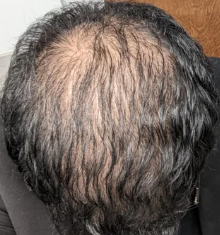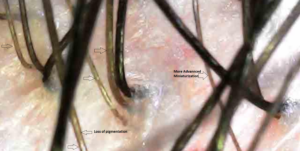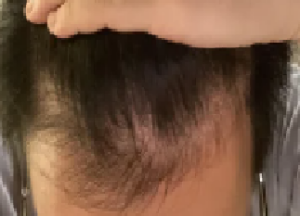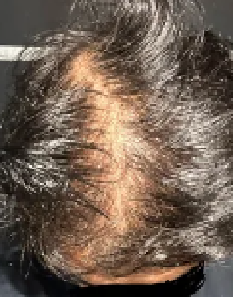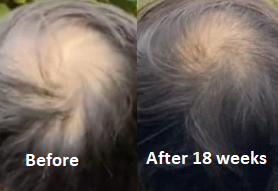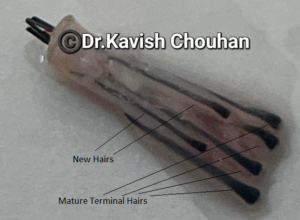Amplifica’s AMP-303 Study
Unveils New Hope for Hair Loss
Treatments
NEWS PROVIDED BY
Amplifica Holdings Group, Inc.
Sep 30, 2024, 09:02 ET
First-in-Human Trial Demonstrates Promising Results for the Treatment of Androgenetic Alopecia SAN DIEGO, Sept. 30, 2024 /PRNewswire/ — Amplifica Holdings Group Inc. (“Amplifica”), a privately held clinical-stage biopharmaceutical company, today announced results from its first-in-human trial of AMP-303, a novel intradermal injectable treatment for androgenetic alopecia (AGA), the most common form of hair loss. The randomized, double-blind, placebo-controlled, multicenter study was designed to evaluate the safety and tolerability of AMP-303, while also evaluating its efcacy. The results suggest that AMP303 has a significant potential to address hair loss after one treatment cycle.
The trial enrolled male participants aged 18 to 45 diagnosed with AGA, and stratified subjects based on the duration of their hair loss. The study divided participants into two distinct groups: those with recent onset of hair loss (3-5 years) and those experiencing more long-standing hair loss (over 10 years). A bilateral paired treatment design in the frontal temporal region was used, where each participant was randomized to receive AMP-303 on one side of the scalp and a placebo on the other, allowing for a direct comparison within individuals. This approach, combined with subject stratification by onset of hair loss, allowed for the analysis of AMP-303’s potential efectiveness across diferent timepoints and stages of hair loss while controlling for individual variability.
Key Study Findings:
-
- Safety Profile: AMP-303 was observed to be safe and well tolerated. The majority of adverse events were mild in severity and no severe adverse events were reported. Local skin reactions to intradermal injections were similar between AMP-303 and placebo, and consistent with other intradermal injections.
- Efcacy: A statistically significant percentage of study subjects (P <0.001) showed a greater than 15% increase in non-vellus hair count from baseline compared to placebo at 60 days post-treatment, and a greater than 10% increase compared to placebo at 150 days post-treatment.
- Durable Results: The study revealed that a single AMP-303 treatment cycle increased non-vellus hair count and sustained hair
density and thickness over time (150 days post treatment), a marked improvement compared to placebo.
- Hair Terminalization: The study results also demonstrated AMP-303’s ability to stimulate the transition of vellus hairs into nonvellus hairs, further emphasizing the treatment’s potential for reversing hair loss.
“The ability to demonstrate measurable improvements in hair regrowth with just one treatment cycle is a breakthrough in addressing androgenetic alopecia,” said Frank Fazio, President and CEO of Amplifica. “The success of the AMP-303 study not only validates our approach but also sets the foundation for advancing additional programs in Amplifica’s pipeline. With this momentum, we are excited to to accelerate the development of new therapies targeting hair regeneration, reinforcing our commitment of developing novel treatments to address androgenetic alopecia.”
William Rassman, MD, a pioneer in hair restoration surgery and Amplifica co-founder, added, “The results observed in the frontal temporal region are particularly encouraging, as this area has traditionally been one of the most challenging to demonstrate a clinical response. AMP-303’s potential to stimulate hair regrowth in this region underscores its unique potential and sets it apart from existing therapies. Findings from this initial clinical study ofers renewed hope for patients struggling with hair loss that have historically been resistant to treatment.”
With the results from this first-in-human study, Amplifica is poised to advance AMP-303 through additional clinical trials to further explore its therapeutic potential for both men and women sufering from hair loss. The company aims to develop AMP-303 as a highly diferentiated option in the hair loss treatment landscape, which is currently limited to daily-use topical and oral therapies.
About AMP-303
AMP-303 is a proprietary, innovative formulation specifically engineered for intradermal injection to target androgenetic alopecia (AGA). Designed to stimulate hair regrowth, AMP-303 has undergone extensive pre-clinical development, including the detailed identification and understanding of its mechanism of action. Proof-of-concept testing in xenograft models has demonstrated its powerful hair growth promoting properties, laying the groundwork for its potential as a transformative treatment. Complementing this scientific advancement is a robust intellectual property portfolio, securing the innovation behind AMP-303 and reinforcing its promise as a groundbreaking solution for individuals sufering from AGA.
About Amplifica Holdings Group, Inc.
Amplifica is a rapidly emerging biopharmaceutical company focused on developing novel treatments to address androgenic alopecia (hair loss), a condition estimated to afect over 50 million men and over 30 million women in the United States alone. The Company is taking a nature-inspired scientific approach using a molecular mechanism that regrows natural hair. The Company has identified and isolated unique signaling molecules that stimulate hair follicles to regrow hair. Amplifica will be initiating product development programs and clinical trials to evaluate the safety and efcacy of its core technology as well as obtaining all applicable regulatory approvals.
For more information, please visit https://amplificabio.com.
Forward-Looking Statements
This press release contains “forward-looking statements” within the meaning of the “safe harbor” provisions of the Private Securities Litigation Reform Act of 1995. Forward-looking statements may be identified by the use of words such as “anticipate,” “believe,” “contemplate,” “could,” “estimate,” “expect,” “intend,” “seek,” “may,” “might,” “plan,” “potential,” “predict,” “project,” “target,” “aim,” “should,” “will,” “would,” or the negative of these words or other similar expressions. These forward-looking statements are based on the company’s current beliefs and expectations. Forward-looking statements include, but are not limited to, statements regarding the potential efficacy of the Company’s product candidates, the Company’s expectations with respect to development and commercialization of the Company’s product candidates, the initiation or completion of any future clinical trials. Actual results may differ from the forward-looking statements expressed by the Company in this press release and consequently, you should not rely on these forward-looking statements as predictions of future events. Forward-looking statements contained in this announcement are made as of this date, and the Company undertakes no duty to update such information except as required under applicable law.
Amplifica’s AMP-303 Study Unveils New Hope for Hair Loss Treatments 9/30/24, 6:08 AM
Contact:
Company
info@amplificabio.com
Media
EvolveMKD – Amplifica@EvolveMKD.com
SOURCE Amplifica Holdings Group, Inc

